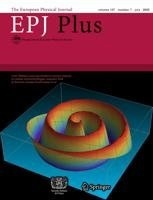Highly focused laser beams, sometimes referred to as optical tweezers (OTs), can be used to handle minuscule objects without applying physical force. OTs are used in various nano- and micro-scale tasks, and they have proven to be exceptionally helpful when manipulating biological materials, such as human cells.

The European Physical Journal Plus. Image Credit: Springer
Recent developments in OTs are described in a new review published in The European Physical Journal Plus. Sheng Hu, Jun-yan Ye, Yong Zhao, and Cheng-Liang Zhu are the review's authors, which was produced by researchers at Northeastern University in Shenyang, China’s College of Information Science and Engineering.
It is well-known that the cell is the basic unit of human life. If we can understand mutation, proliferation, and necrosis of cells, diseases inside the human body would be discovered and solved in the level of the cell. Thus, optical tweezers, are a can be thought of as a pioneer used to confine these molecules so that more precise bio-measurement could capture the changes in one cell, including protein, mitochondria, and DNA.
Sheng Hu, College of Information Science and Engineering, Northeastern University
The authors begin by tracing the history of OTs to the work of James Clerk Maxwell and the finding that light can have momentum even if it has no mass. The momentum of light might have a mechanical impact on the properties of matter. This theory would eventually be expanded to include the notion that optical instruments could suspend small particles.
The authors note that optical manipulation of such micro-particles began in the 1980s with the development of laser equipment, which produced coherent light with high intensity and good monochromatic properties. In 1986, stable microparticle trapping was achieved.
OTs have now reached the point where they can be utilized to transport, enrich, sort, and trap different types of biological particles. For more difficult and delicate operations, single optical beams are now supported by tools such as acousto-optic modulators and electric vibrating mirrors.
The researchers also mention the application of OTs in conjunction with a brand-new “human bright eye” microscopy setup to reveal the microstructure of micro/nano-particles. This implies that OTs can hold onto these particles delicately as this fictitious human eye examines them, acting as a “human slender finger.”
The team explains the benefits that OTs have over similar methods such as atomic force microscopes (AFM), magnetic tweezers (MT), and acoustic tweezers (AT). These advantages include offering a stronger force with a finer resolution, non-invasive, and many optical components.
This means that optical manipulation in general and OTs, in particular, have found applications in various sectors, including biology, pharmacology, and clinical research, which can capture nano and microparticles ranging from molecules to cells.
Hu added, “Considering the potential ‘real world’ applications of OTs there is still a long way to go. For example, the problem of radiation exposure to cells or proteins needs to be improved. Moreover, achieving stability of optical patterns to submicro-scale particles is still tough, reflecting a complicated optical adjustment.”
“Although this can lead to confusion and even sometimes frustration, the intriguing biological presentations motivate us to facilitate the progress of the technique,” Hu concluded.
Journal Reference
Hu, S., et al. (2022) Advanced optical tweezers on cell manipulation and analysis. The European Physical Journal Plus. doi:10.1140/epjp/s13360-022-03190-9
Source: https://www.springer.com/gp